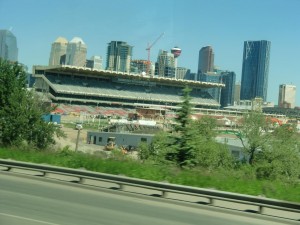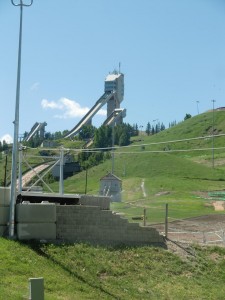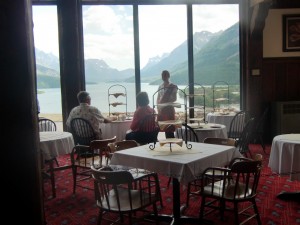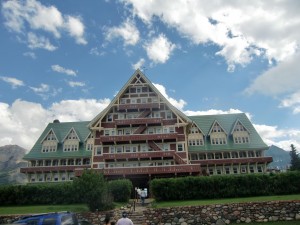EXPLORING THE ROCKIES – CALGARY AND THE FLAT PLAINS
EXPLORING THE ROCKIES
This is the fifth in a series of articles about traveling in the Canadian Rockies
CALGARY AND THE FLAT PLAINS
By Charles N. Stevens
Photos by Dolores Seidman
Even though the sun shines brightly on the great “rock” or peak that we see from our hotel window, sun-filled low clouds form a wreath below its lofty height. Sometimes the clouds rise, hiding the sheer rock face and patches of snow. After breakfast Dolores and I again walk along the smooth-flowing Bow River, the air crisp, the grasses saturated with dew.
Shortly after eight we leave for Calgary, soon finding flood damage along the highway where dirt and rocks and even tree trunks carried by the swollen river had been deposited. We are traveling on the Trans-Canada Highway, Highway 1, yet even here we come upon signs reading “Elk Crossing.” But we don’t see any. Near the town of Canmore we see a devastating scene where the river had burst its banks and gouged small canyons between the houses. Many yellow school buses are inundated in a parking lot, the pooled water still up to their windows.
Our bus gradually rolls out of the Rockies into flatter and flatter land, from green hills into level farmland with fields of wheat and others brilliant with the saturate yellow of rapeseed. We pass ranches with cows grazing, small lakes and farm houses.
On the outskirts of Calgary where there are many new housing tracts is a sign that reads, “Heart of the New West.” We pause for a while to look at the towering Olympic ski jumps in the Canada Olympic Park and displays featuring the jumps when covered with snow. The Winter Olympics were held here in 1988. The Canada Olympic Park is still used and is being expanded. From the park we can see the clustered skyscrapers of downtown Calgary to our east.
Shortly after ten, we enter the city with its towering buildings and its tall TV tower. Light rail viaducts lead into the city and provide excellent service. Most buildings are linked with skyways, a sort of enclosed bridge leading from one building to another that provides protection for workers and shoppers during the freezing winters of the plains. Most buildings are modern, constructed of metal and glass like those of other leading cities. The Calgary Tower features a restaurant on top that revolves and gives diners panoramic views of the city. Parts of downtown had been flooded when the Bow River overflowed its banks, the dust left from the deposited silt still being churned up by cars. Hardest hit was the area where the famous Calgary Stampede is held every year, the water rising partway into the stands. Heavy equipment is busy trying to clean up and prepare the area so the grand rodeo and chuck wagon races can go ahead as planned. Calgary has a long scenic walkway along the river and miles of bike trails to provide for healthy living. There are 57 parks in the city.
We have Chinese food for lunch in a beautiful mall with a great glass roof in downtown Calgary. Sunlight streaming in from the outside fills the food court and the entire building with light. Calgary is a wonderful city, and we hate to leave it.
We flow out of Calgary with Sunday traffic, the sky sunny and clear flecked with a few clouds. We roll by housing tracts and shopping malls and a sign that says abut Calgary, “More Alberta, less Toronto.” As we travel, the land levels out even more. Vast green fields and occasional farmhouses with barns and silos alternate with each other. When I see isolated houses, I wonder how they ever cope with winter. I suspect they will spend a lot of indoor time. We zip through towns like Nanton with its Bomber Command Museum and Stavely with its grain elevators.
Heading away from the flatland, we again veer toward another section of the Rockies. After reaching them, we enter Waterton Park, eventually stopping at the spectacular Prince of Wales Hotel sitting high on a promontory overlooking Waterton Lake. It is a five-story wooden hotel painted barn red with white trim and a steeply sloped green roof. Large dormer windows peek out of the roof and a triangular cupola reigns high overall. The hotel is set down in a natural scene of great beauty with breathtaking views of the lake and the peaked mountains that surround it. Walking around in the beauty of the setting and the old hotel itself is an experience we will never forget.
Too soon we are on our way to Lethbridge where we will stay for the night. We pass through more farmland and the small towns of Mountain View, Leavitt and Cardston, the latter being the site of the only Mormon temple in Canada. We arrive rather late at the Lethbridge Lodge where we have a nice dinner and a welcome, comfortable room to sleep in.

As workers are busy repairing the grounds for the Calgary Stampede, the towering buildings of the city can be seen in the background.

One can imagine the thrill of speeding down one of these ski jumps in Canada Olympic Park.

Diners at the Prince of Wales Hotel look out over Waterton Lake.

We are astounded at the magnificence of the Prince of Wales Hotel in Waterton Park.
MONTEREY PARK AUTHOR PUBLISHES 4th BOOK – Seeking More of the Sky: Growing Up in the 1930’s:
Charles “Norm” Stevens, a 43 year resident of Monterey Park has recently published his 4th book: Seeking More of the Sky: Growing Up in the 1930’s. This is the story of a young boy growing up in Inglewood, California in the l930’s. This was a time during the depression when unemployment was affecting many and the banks were closed, while the clouds of war were gathering in Europe. But he was lucky enough to be raised in a loving family, the power of that love reflected throughout his stories.
Stevens is the author of three previous books about his experiences during WWII:
An Innocent at Polebrook: A Memoir of an 8th Air Force Bombardier (Story of his 34 bombing missions from his base at Polebrook, England over Germany and France)
The Innocent Cadet: Becoming A World War II Bombardier (A prequel to the first, telling of his training in the U.S. before going overseas into combat.)
Back from Combat: A WWII Bombardier Faces His Military Future from Combat: (This book details the time from when he returned from combat in England until the end of the war.)
He is known to the readers of The Citizen’s Voice as the author of Travel Log Articles including “Cruising the Rhine and Mosel”,” Best of the West”, “In Search of Snow” , “From Paris to Normandy on the Seine”, and “Exploring New York”. He is retired, having taught for 32 years, primarily in the Montebello Unified School District.
Those interested in purchasing an autographed copy of any of his books, may contact the author at 323-721-8230 or Normstevens24@gmail.com.



